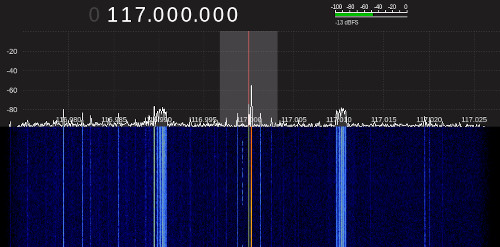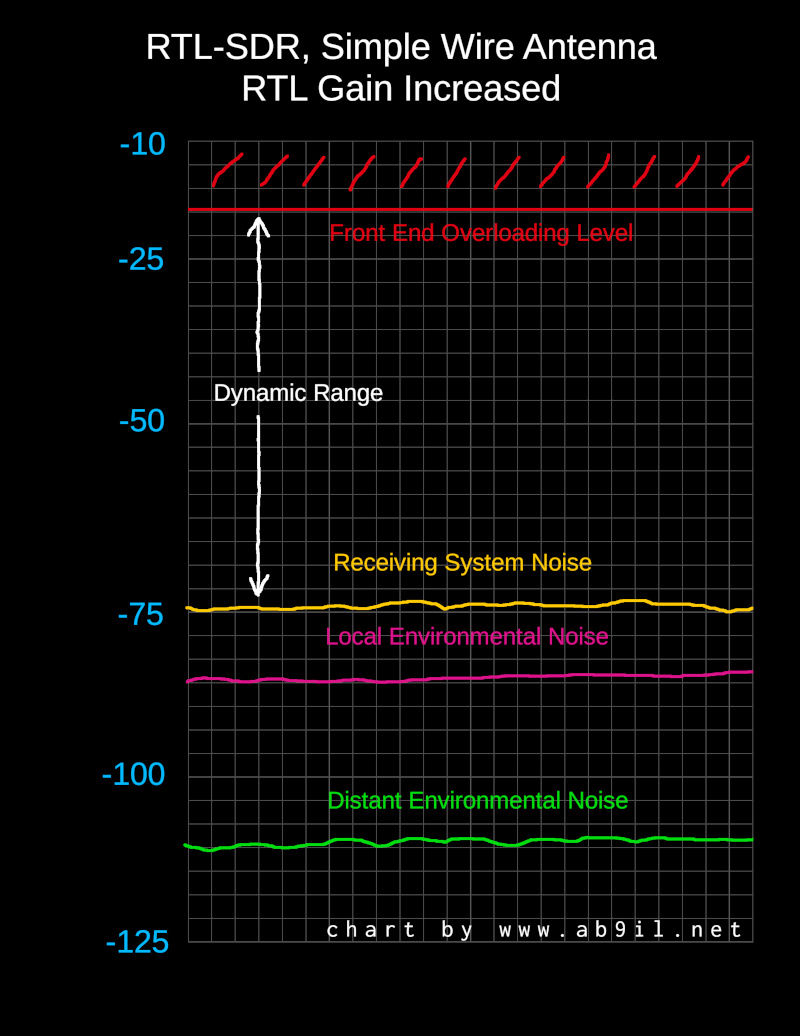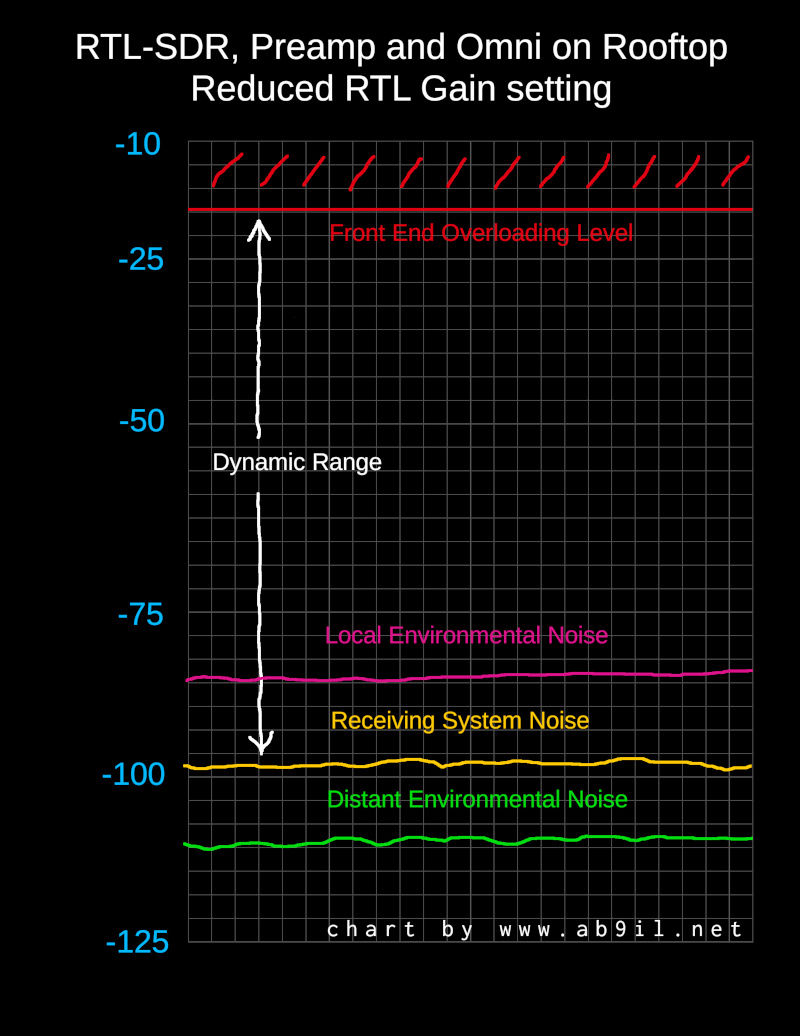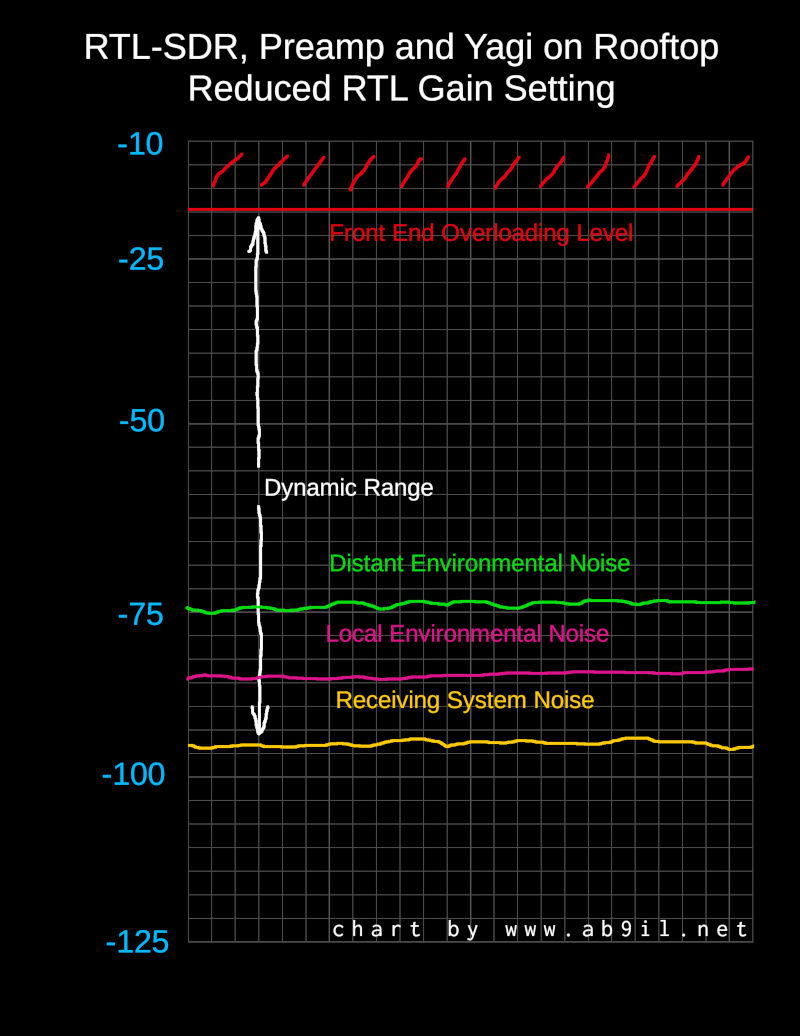As a user of RTL-SDR devices
for tasks such as aero monitoring, ACARS, ADS-B, or perhaps VHF maritime or
satellite listening, you may sometimes question the sensitivity of your radio.
The answer is more complex than, "how high is the S-meter indication?" To have
precise metrics, it is necessary to connect the dongle to a test rig, measure
the noise, and inject a weak signal to compare with the noise. But hey, you can
make practical assumptions about your receive sensitivity by knowing your
configuration and examining the layers of background noise you can receive.

RTL-SDR receiving a weak VOR station on 117.0 MHz
amid lots
of birdies and other neighborhood interference.
Manufacturer's data indicates that an RTL-SDR has fair sensitivity - enough
for local and more distant broadcasters and typical aero / maritime mobile
stations. With a quarter wave vertical or one wavelength loop, mounted on a
rooftop, high altitude flights should be audible out to 200 miles. Boats or
aircraft on an airport should be audible out to about 20 miles. Distances may
be increased significantly, even without a preamplifier, with the use of a
directional antenna.
If you use the stock antenna (the whip usually included when you buy an RTL-SDR),
the problem is that the antenna won't be high up, in the clear, and exposed to better
signals. Also, it doesn't have gain or directivity. The noise floor will be set
by the RTL-SDR internal RF amplifier and oscillator phase noise.
If you can afford the higher cost, avoid the cheap off-the-shelf receiver dongles
and instead get an
upgraded RTL-SDR version, with a much less noisy oscillator.
All other things being equal, these are more sensitive devices.

RTL-SDR sensitivity without an LNA: weak signals lost in noise.
In the chart above, notice that the level of noise from neighborhood sources
is below the receiver's internal noise. Also, there is another noise level, for
distant sources (including cosmic noise), which is far below the hiss generated
in the RTL-SDR.
Improve Your Antenna First
Simply increasing your gain settings does not help. The problem is that the
first RF amplifier (or the mixer) in a radio is what sets the noise figure. A
sensitive radio will have a noise figure of about 1 or 2 dB on VHF and UHF. The
RTL-SDR has a noise figure of 5 to 8 dB, depending on the frequency and whether
you received a good unit in terms of manufacturing tolerances. While it is
possible to set your device gain too low and lose the front end noise floor below
other noise added by the mixer and IF amplifier, there is no advantage to set the
gain above about 25 on the RTL-SDR. Too high a gain setting simply causes more
overloading and spurious junk to be created within the dongle.

RTL-SDR becomes neighborhood noise limited with a good omni antenna and LNA.
Use a Quality Preamplifier
After installing a directional antenna as high as possible, and using a low
loss feedline to the receiver, station sensitivity can be improved by adding a low
noise preamplifier. The term "low noise" means the preamp should have a noise
figure below 1 dB, and the lower the better. Install the preamp at the antenna
feedpoint, or through a short length of low loss cable. Typically, high gain is
not necessary - 15 dB is plenty; more gain than 20 dB is often a waste and
probably will cause troubles with overloading. If you do experience problems
with overloading, especially from out of band stations, consider to install
a filter ahead of the preamplifier. There are inexpensive and effective filters
available for weather satellite, maritime, and ADS-B spectrum bands.
The Experience of a Sensitive Receiver
How do you know if your receiver is sensitive enough, after installing a better
antenna and preamplifier? On an omnidirectional antenna, such as a ground plane
vertical you should be able to hear background noise from your surroundings.
Listen for automobile or truck spark plug noise, lightning from nearby thunderstorms,
and powerline noise (yes - at VHF and UHF). These comprise the next limit - the next
noise floor once you overcome the noise within your receiver.
Reception should be better for the things you seek, and more distant stations
should be detectable when enhanced by tropospheric bending on good days or evenings.
When you disconnect the antenna from your RTL-SDR, the neighborhood background
noises should disappear. When you reconnect the antenna, those noises should return.
Replacing a dipole, vertical, or single loop with a three to five element yagi
antenna can bring weak signals up above the neighborhood noise and extend your max
range by a solid fifty percent (limited by the radio horizon). What you should observe
is stations within range having stronger signals, then a sharp drop for any beyond
the visual horizon, then fluttery and weak signals out to approximately thirty percent
past said visual horizon. Whenever there is propagation enhancement due to tropospheric
bending or scatter from aircraft, you can receive signals at greater distances.
On a receiver with a noise figure much lower than of the RTL-SDR, the beam
antenna and preamplifier combination can make a significant improvement in
station sensitivity. Antenna directivity is important, as it receives more energy
from the aimed direction and less noise from around the local neighborhood. When
local noise is no longer marking the floor, the next floor is distant sources. A
superbly optimized station can detect cosmic sources, such as the sun, moon, Jupiter,
and Saggitarius (our galactic center).

With a beam antenna, LNA, and good cable, RTL-SDRs can reach beyond local
noise and receive distant, weak signals.
If you consider the above information and make improvements to your receiving
station, you can take steps to assure that your rig is "sensitive enough" to pick up
whatever is in your area.
© 2015 - 2025 Skywavelinux.com, All Rights Reserved.
Written and curated by Webmaster - Developer Philip Collier
Contact, Privacy Policy and Disclosures, XML Sitemap.



